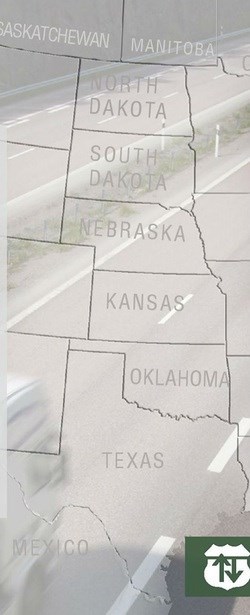The implications surrounding the impending twinning of Highway 39 and Highway 6 (south) in southeast Saskatchewan is now stretching into the neighbourhood that includes North and South Dakota.
Steve Pedersen, a co-ordinator and advocate for the Central North American Trade Corridor that embraces the No. 39 and No. 6 highway route for international movement of goods and people, told the Mercury last week there will be a corresponding need to super size the connecting highway(s) on the American side of the equation. Not to do so will, “create a bottleneck of trade and traffic in North Dakota.”
Pedersen, a former educator at Minot State University, said the CNATC is lobbying the federal as well as the state governments for an action plan that will work in concert with the Saskatchewan plan to create a four-lane expressway from North Portal to Regina.
“I honestly think that as the talks move forward, Minot representatives should be joining your Estevan and Weyburn representatives at the table for mutual planning sessions,” said Pedersen.
Marge Young, spokeswoman for the Time to Twin committee in Estevan and Weyburn, said she and twinning advocate Laurali Ireland met with Pedersen last week and engaged in a wide-ranging discussion regarding their mutual interests in getting highway-based traffic moving more efficiently and safely.
The trade corridor committee has been working diligently on a preferred route from northern Mexico up to western Canada for a couple of decades and has been making progress in terms of unifying regulations and formulating commercial trucking routes that would encounter the least resistance. The committee also focuses on other central NA trade and traffic issues such as airports and airlines, rail routes and international border requirements. They focus on the four T’s, they said in a recent release. That means, trade, tourism, technology and transportation.
Pedersen said the corridor advocates and committees have had periods when they are very busy and consumed by regional interests and then have taken a rest, only to be revived again when new problems or ideas surface that need to be addressed. These interests include interstate and international trade involving Midwestern and panhandle states and the Canadian provinces of Manitoba, Saskatchewan and Alberta.
“Estevan to Minot and Minot to Estevan is already a busy highway so there have to be efforts made on both sides of the border to make it safer. We may not be able to get a four-lane highway built, but we should be able to get a Super 2 highway,” he said, explaining this meant a highway with wider shoulder widths and frequent and strategically placed passing lanes.
“If we built a four lane on Highway 52 south of Kenmare, through the valley, crossing the river and railway, it would mean a huge expense,” said Pedersen. “But if oil bounces back again, we’ll certainly have a stronger voice as advocates for safety, just as your people did.”
The CNATC has held international symposiums and plenary sessions in the past to bring interested parties together and they will be doing so again May 18-20 in Bismarck, N.D.
“It’s a summit that is attracting all types of people interested in this trade corridor because the corridor has advantages,” said Pedersen. “There will be presentations on all types of business and traffic like delivering products by drones or dirigibles and autonomous vehicles. In fact, highways may be the least important structure in the future,” he said with a chuckle. “That’s why we hope to have some Canadian representation there. I understand your provincial government has put a block on travel budgets, but I know the premier has been an advocate of increased relationships between Saskatchewan and North Dakota and Montana in the past. We’d like to see someone here representing Saskatchewan interests because we have pretty positive things happening between our governments.”
Pedersen said traditionally speaking, highways are built in the U.S. using a formula that places 80 per cent of the cost on federal shoulders and 20 per cent on the states. In some instances, the state has moved forward with highway upgrades ahead of schedule, such as those that were needed to accommodate the increased traffic in North Dakota thanks to the Bakken and Three Forks oilpatch rush, near places such as Watford City and Williston.
“We can’t endanger travellers … commercial or tourists, coming to our side of the border and we know for a fact traffic will increase again. In fact I expect it to double into Minot because transborder traffic coming off your No. 1 Highway, needing to go south, will slide onto No. 39, if it is four-lanes. So you’ll have more traffic, we’ll have more traffic and it needs to run safely," Pedersen said. “Truckers have deadlines, so they have to pick up lost time if they are delayed at crossings or due to weather.”
The corridor advocate also noted that there is a rail traffic increase, including trains now coming from the Northgate hub, and that traffic is coming south with 100 car loads. “Airlines will be getting busier. It all means more activity and need for better infrastructure. On our side, for instance, we have to look at what it costs to build a new four-lane road from Williston to Portal. My guess is around $250 million,” Pedersen added.
He said the trade corridor team’s summit in Bismarck will be addressing not only transportation but also other types of businesses that can be interchangeable such as mining and power production, once the visionary minds get to work.
“It’s all rather exciting. Transportation is changing dramatically, so we have to decide what we’re building and how we’re building it,” he said.



